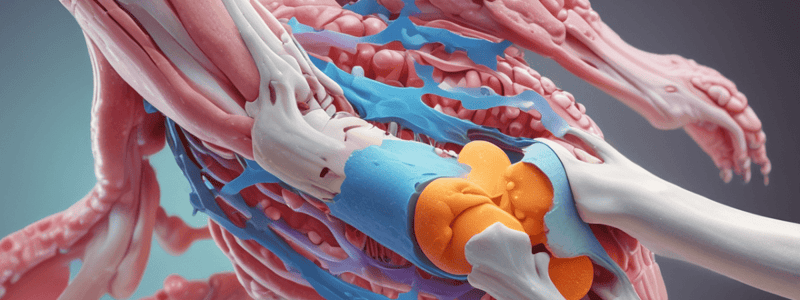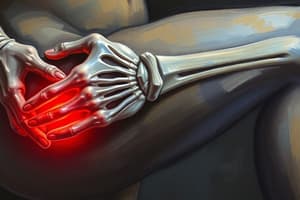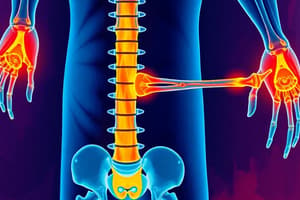Podcast
Questions and Answers
What is the primary symptom of osteoarthritis?
What is the primary symptom of osteoarthritis?
- Swelling
- Pain (correct)
- Redness
- Numbness
Which of the following is NOT a structure affected by osteoarthritis?
Which of the following is NOT a structure affected by osteoarthritis?
- Muscles
- Ligaments
- Capsule
- Blood Vessels (correct)
Why are older adults more susceptible to osteoarthritis?
Why are older adults more susceptible to osteoarthritis?
- Environmental toxins
- Due to hormonal changes
- Increased risk with age (correct)
- Because of genetic factors
What is the term commonly used to describe osteoarthritis?
What is the term commonly used to describe osteoarthritis?
Which factor contributes to the development of osteoarthritis according to the text?
Which factor contributes to the development of osteoarthritis according to the text?
What type of pain can manifest in osteoarthritis?
What type of pain can manifest in osteoarthritis?
Which structure beyond the articular cartilage is affected by osteoarthritis?
Which structure beyond the articular cartilage is affected by osteoarthritis?
What contributes to the complex mechanisms of pain in osteoarthritis?
What contributes to the complex mechanisms of pain in osteoarthritis?
What makes women more likely to develop osteoarthritis?
What makes women more likely to develop osteoarthritis?
What distinguishes osteoarthritis from other forms of arthritis?
What distinguishes osteoarthritis from other forms of arthritis?
What is a significant risk factor for developing osteoarthritis?
What is a significant risk factor for developing osteoarthritis?
How is osteoarthritis diagnosed?
How is osteoarthritis diagnosed?
Which of the following is NOT a common diagnostic criteria for osteoarthritis?
Which of the following is NOT a common diagnostic criteria for osteoarthritis?
What is the main aim of osteoarthritis treatment?
What is the main aim of osteoarthritis treatment?
Which of the following is NOT a type of pharmacological treatment for osteoarthritis?
Which of the following is NOT a type of pharmacological treatment for osteoarthritis?
In what scenario might joint replacement surgery be considered for osteoarthritis?
In what scenario might joint replacement surgery be considered for osteoarthritis?
What role does family history play in the development of osteoarthritis?
What role does family history play in the development of osteoarthritis?
Study Notes
Understanding the Complex Nature of Osteoarthritis: From Symptoms to Treatments
Osteoarthritis (OA), commonly referred to as wear-and-tear arthritis, is the most common form of arthritis. It is characterized by the progressive deterioration of articular cartilage, resulting in pain, stiffness, and dysfunction of affected joints. Despite being the fourth leading cause of disability globally, treatment options for OA remain limited. In this article, we delve into the intricate nature of OA, discussing its symptoms, causes, diagnosis, and treatments.
Osteoarthritis: A Painful Chronic Disease
Osteoarthritis is a heterogeneous condition affecting the elderly, with pain being the primary symptom. Pain can manifest as either intermittent or constant, and its mechanisms are complex, involving both peripheral and central processes. The disease affects the entire joint, including structures beyond the articular cartilage, such as the subchondral bone, ligaments, capsule, synovial membrane, and periarticular muscles.
Causes of Osteoarthritis: A Multifactorial Condition
OA is not caused by a single factor but rather by a combination of systemic, genetic, biomechanical, and environmental influences. Several risk factors contribute to the development of OA, including:
- Age: The risk of developing OA increases with age, making older adults more susceptible.
- Sex: Women are more likely to develop OA than men, especially after the age of 50 years.
- Obesity: Excess weight puts additional stress on joints, particularly weight-bearing joints like hips and knees, increasing the risk of OA.
- Genetics: Family history plays a role in determining an individual's predisposition to OA.
- Joint injury or overuse: Damage to joints due to trauma or repetitive stress can accelerate the development of OA.
Diagnosis of Osteoarthritis: Clinical and Radiographic Evaluation
Doctors diagnose osteoarthritis through a combination of clinical examination, patient history, imaging studies like radiography, and sometimes laboratory tests. Common diagnostic criteria include pain, stiffness, swelling, reduced range of motion, and crepitus.
Treatment Strategies for Osteoarthritis: A Multimodal Approach
There is no cure for OA, and treatment typically aims to alleviate symptoms and slow disease progression. Available therapies include:
- Nonpharmacological interventions: Physical therapy, weight loss, and joint protection strategies to reduce stress on affected joints.
- Pharmacological treatments: Over-the-counter pain relievers, nonsteroidal anti-inflammatory drugs (NSAIDs), and prescription medications for pain management.
- Supportive devices: Braces, canes, and other assistive devices to improve mobility and reduce strain on affected joints.
- Surgery: Joint replacement surgery may be considered when other treatments fail to provide adequate relief.
Conclusion: Understanding the Complexities of Osteoarthritis
Osteoarthritis is a complex and heterogeneous condition that impacts millions worldwide, causing significant disability. While there is no cure, understanding its causes and developing tailored treatment strategies can help manage symptoms and improve quality of life for those affected by this painful chronic disease.
Studying That Suits You
Use AI to generate personalized quizzes and flashcards to suit your learning preferences.
Description
Explore the multifaceted nature of osteoarthritis (OA) - the most common form of arthritis affecting millions worldwide. Learn about the symptoms, causes, diagnosis, and treatment strategies for managing this complex and chronic condition.





